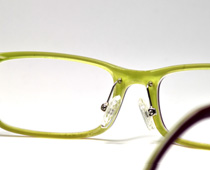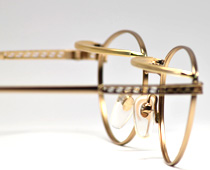Watch Us in Action Repairing Glasses in the Lab
Modification of Eyeglasses and Sunglasses
Nose Pad Arm Inserts
Cable Temple Tips
Eye Crutches: Ptosis-Crutch
The Extension of Temples on Eyewear
Electro-Plating
Lenses and Coatings
Eye Crutches - Ptosis Crutch
The eye crutch is also known as the Ptosis crutch because of its direct reference to the cause of the need for the crutch (Ptosis: drooping eye syndrome). Most often a standard measurement is between 10 to 15mm, but extended length may be addressed for deeper pitted eye sockets. For the most part the eye crutch can be attached to most frames, including metals and plastic frames, with the proper equipment. It is important to address non allergic materials like titanium/nickel alloys and metals alike and also most plastic frames. Considering durability, metal frames seems to resist the most to breakage. There are several different forms of the eye crutch. The two most common are the adjustable and reinforced.
Adjustable Eye Crutches:
The adjustable eyecrutch is attached to the frame on one side, usually the nasal side. The benefit of this method, besides the obvious adjustable factor, is that this is the least altering to the frame. However, the disadvantage of this method seems to be that they constantly have to be adjusted consequently weakening the metal at its pivotal point of adjustment, which commonly results in broken crutches
Reinforced Eye-Crutch:
The reinforced eye-crutch is attached on both ends of the crutch (per eye crutch). This method of the eye crutch is slightly adjustable up and down. The double attachment of the crutch creates the most durable method and is resistant to breakage. Also included with the eye crutches is a clear plastic coated finish to address anti-allergic sensitivity and comfort for eye lid positioning.
Comfort and necessity are a key factor when it comes to eyewear. Now if you consider fashion and special needs some eyeglasses and/or sunglasses may have to be modified to accommodate some personal needs and/or preferences creating a comfortable eyewear. Below are some categories, which describe the details of each respective modification




